Structural formula
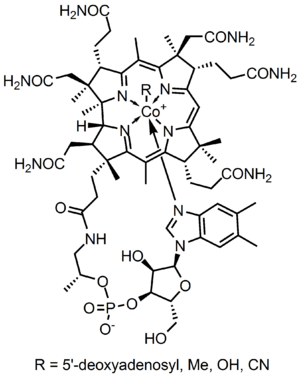
The structural formula of a chemical compound is a graphic representation of the molecular structure, showing how the atoms are arranged. The chemical bonding within the molecule is also shown, either explicitly or implicitly. Unlike chemical formulas, which have a limited number of symbols and are capable of only limited descriptive power, structural formulas provide a complete geometric representation of the molecular structure. For example, many chemical compounds exist in different isomeric forms, which have different enantiomeric structures but the same chemical formula. A structural formula is able to indicate arrangements of atoms in three dimensional space in a way that a chemical formula may not be able to do.
Several systematic chemical naming formats, as in chemical databases, are used that are equivalent to, and as powerful as, geometric structures. These chemical nomenclature systems include SMILES, InChI and CML. These systematic chemical names can be converted to structural formulas and vice versa, but chemists nearly always describe a chemical reaction or synthesis using structural formulas rather than chemical names, because the structural formulas allow the chemist to visualize the molecules and the structural changes that occur in them during chemical reactions.
Lewis structures
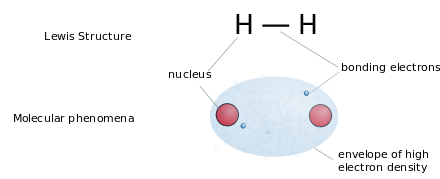
Lewis structures (or "Lewis dot structures") are flat graphical formulas that show atom connectivity and lone pair or unpaired electrons, but not three-dimensional structure. This notation is mostly used for small molecules. Each line represents the two electrons of a single bond. Two or three parallel lines between pairs of atoms represent double or triple bonds, respectively. Alternatively, pairs of dots may be used to represent bonding pairs. In addition, all non-bonded electrons (paired or unpaired) and any formal charges on atoms are indicated.
 The Lewis structure of water
The Lewis structure of water
Condensed formulas
In early organic-chemistry publications, where use of graphics was strongly limited, a typographic system arose to describe organic structures in a line of text. Although this system tends to be problematic in application to cyclic compounds, it remains a convenient way to represent simple structures:
CH3CH2OH (ethanol)
Parentheses are used to indicate multiple identical groups, indicating attachment to the nearest non-hydrogen atom on the left when appearing within a formula, or to the atom on the right when appearing at the start of a formula:
(CH3)2CHOH or CH(CH3)2OH (2-propanol)
In all cases, all atoms are shown, including hydrogen atoms.
Skeletal formulas
Skeletal formulas are the standard notation for more complex organic molecules. In this type of diagram, first used by the organic chemist Friedrich August Kekulé von Stradonitz, the carbon atoms are implied to be located at the vertices (corners) and termini of line segments rather than being indicated with the atomic symbol C. Hydrogen atoms attached to carbon atoms are not indicated: each carbon atom is understood to be associated with enough hydrogen atoms to give the carbon atom four bonds. The presence of a positive or negative charge at a carbon atom takes the place of one of the implied hydrogen atoms. Hydrogen atoms attached to atoms other than carbon must be written explicitly.
 Skeletal formula of isobutanol, (CH3)2CHCH2OH
Skeletal formula of isobutanol, (CH3)2CHCH2OH
Indication of stereochemistry
Several methods exist to picture the three-dimensional arrangement of atoms in a molecule (stereochemistry).
Stereochemistry in skeletal formulas
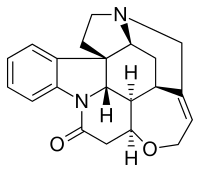
Chirality in skeletal formulas is indicated by the Natta projection method. Solid or dashed wedged bonds represent bonds pointing above-the-plane or below-the-plane of the paper, respectively.
Unspecified stereochemistry
Wavy single bonds represent unknown or unspecified stereochemistry or a mixture of isomers. For example, the adjacent diagram shows the fructose molecule with a wavy bond to the HOCH2- group at the left. In this case the two possible ring structures are in chemical equilibrium with each other and also with the open-chain structure. The ring continually opens and closes, sometimes closing with one stereochemistry and sometimes with the other.
Skeletal formulae can depict cis and trans isomers of alkenes. Wavy single bonds are the standard way to represent unknown or unspecified stereochemistry or a mixture of isomers (as with tetrahedeal stereocenters). A crossed double-bond has been used sometimes, but is no longer considered an acceptable style for general use.[1]

Perspective drawings
Newman projection and sawhorse projection
The Newman projection and the sawhorse projection are used to depict specific conformers or to distinguish vicinal stereochemistry. In both cases, two specific carbon atoms and their connecting bond are the center of attention. The only difference is a slightly different perspective: the Newman projection looking straight down the bond of interest, the sawhorse projection looking at the same bond but from a somewhat oblique vantage point. In the Newman projection, a circle is used to represent a plane perpendicular to the bond, distinguishing the substituents on the front carbon from the substituents on the back carbon. In the sawhorse projection, the front carbon is usually on the left and is always slightly lower:
 Newman projection of butane
Newman projection of butane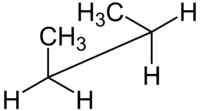 sawhorse projection of butane
sawhorse projection of butane
Cyclohexane conformations
Certain conformations of cyclohexane and other small-ring compounds can be shown using a standard convention. For example, the standard chair conformation of cyclohexane involves a perspective view from slightly above the average plane of the carbon atoms and indicates clearly which groups are axial and which are equatorial. Bonds in front may or may not be highlighted with stronger lines or wedges.
 Chair conformation of beta-D-Glucose
Chair conformation of beta-D-Glucose
Haworth projection
The Haworth projection is used for cyclic sugars. Axial and equatorial positions are not distinguished; instead, substituents are positioned directly above or below the ring atom to which they are connected. Hydrogen substituents are typically omitted.
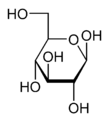 Haworth projection of beta-D-Glucose
Haworth projection of beta-D-Glucose
Fischer projection
The Fischer projection is mostly used for linear monosaccharides. At any given carbon center, vertical bond lines are equivalent to stereochemical hashed markings, directed away from the observer, while horizontal lines are equivalent to wedges, pointing toward the observer. The projection is totally unrealistic, as a saccharide would never adopt this multiply eclipsed conformation. Nonetheless, the Fischer projection is a simple way of depicting multiple sequential stereocenters that does not require or imply any knowledge of actual conformation:

Fischer projection of D-Glucose
See also
References
- ↑ J. Brecher (2006). "Graphical representation of stereochemical configuration (IUPAC Recommendations 2006)" (PDF). Pure Appl. Chem. 78 (10): 1897–1970. doi:10.1351/pac200678101897.
External links
- The Importance of Structural Formulas
- Structural formulas
- How to get structural formulas using crystallography
